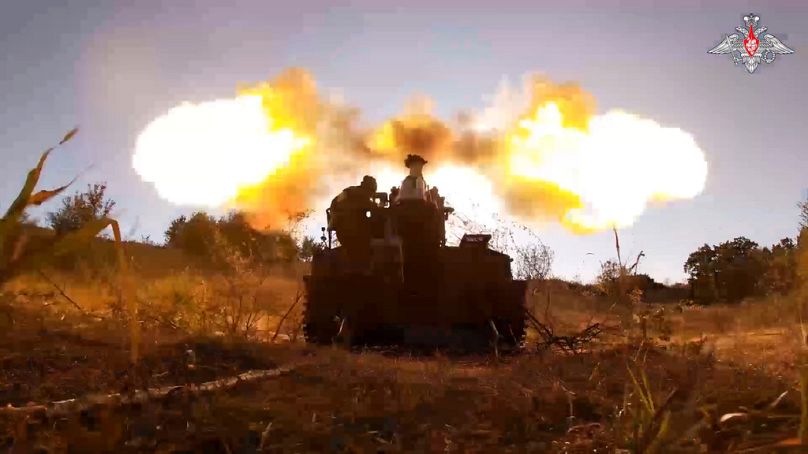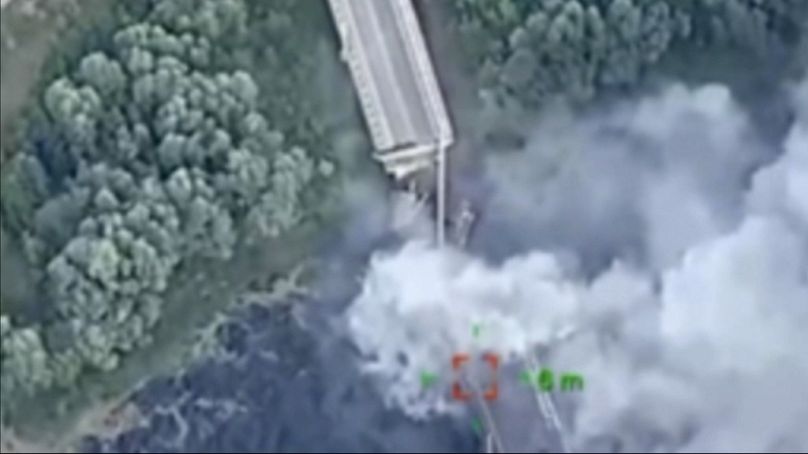While Ukrainian forces extend their control on Russian territory, Kyiv's military is losing ground in the Donbas. The Kursk incursion could either play a significant political role in the war's outcome or become a military nightmare for both sides.
The Russians and the Ukrainians seem to be fighting in two parallel dimensions: both contending armies claim military success in two different regions.
While the Ukrainian incursion in the western Russian territory of Kursk seems to be steadily gaining ground, the Russians are close to achieving a goal of their own in the Donbas after they took the town of Niu-York and advance on a key transport junction of Pokrovsk.
In the Kursk area, the Ukrainian forces are trying to seize Korenovo. The fall of this city would allow them to strengthen their defences in Russian territory and build a coherent "buffer zone" to protect Kharkiv and other northern cities.
Such a buffer zone, stated by President Volodymyr Zelenskyy to be the incursion's main goal, would be a major operational success for the Ukrainians.
The two sides' different goals lead to different measures of success: officials in Kyiv are keeping a close eye on the number of square kilometres of Russian territory that their military controls, while the Russian forces aim to dismantle the Ukrainian fortifications that have been built in the Donbas since 2014.
Both offensives are also happening at different speeds: Ukraine's advance in the Kursk region is currently faster than Russia's in the Donbas, and while Ukraine may be forced to withdraw there, it's already damaged transport infrastructure that could further hinder Russia's forward march.
Political and diplomatic leverage
Ukraine's surprise offensive in Kursk raised eyebrows across the world, with its true purpose remaining something of a mystery.
Some experts believe Kyiv may have had the US elections at the back of its mind when it launched the attack.
"One of the explanations of this operation by the Ukrainians is to gain leverage because elections in the US are coming," said Joni Askola, a Finnish military analyst from Prague's Charles University. "A lot of partners and allies of Ukraine are maybe starting to push this idea of negotiations and Ukraine wants to keep control over that process in case they are forced into negotiations."
"So, by taking land in Russian territory, they [the Ukrainians] keep control of this process, make it less likely that they would get forced into any negotiations," Askola added.
All eyes will turn to the US presidential election in the coming months, and its result will have a direct influence on the Western world's role in Russia's war against Ukraine.
In the event its Western allies pressured it into negotiations, the Ukrainians needed to have an ace up their sleeve that they could present to all parties, be they partners or aggressors, according to experts.
Another objective of the Kursk incursion was to draw Russian troops away from the southeastern front. Yet observers have said that so far Moscow does not seem to have significantly reduced its military presence in the Donbas and Kyiv has actually ordered civilians to evacuate the city of Pokrovsk — likely Russia's next target.
Raising the stakes?
Following its relative success so far in Kursk, could Ukraine be tempted to up the ante and open a new front by the sea in the south?
Ukraine's special forces have proved to be quite skilled in water operations, having inflicted huge damage to the Russian fleet and its coastal facilities, particularly in Crimea.
Kyiv's allies have also boosted its amphibious arsenal, with Sweden, Finland and others providing it with weaponry and speed boats.
"In terms of logistics, this [opening a front in Crimea] could be quite complicated and it would require a lot of manpower, pontoons, and other costly material," Askola said. "Crossing the Dnipro River in the area of Kherson could be also an option, but it would require a lot of resources too."
Regardless of its next steps, Ukraine has taken control of Russian territory.
It's the first time since 1941 that a foreign army has violated Russian soil, which could have a lasting effect in the minds of Ukraine's allies and the Russian people themselves, even if Kyiv is eventually forced to withdraw.
President Zelenskyy had said that the incursion into Kursk has proved that the Kremlin's supposed red lines for retaliation are a bluff, adding that Ukraine would not have needed to physically invade Russian territory had its allies not prohibited it from using their weapons to strike targets on Russian soil from afar.
Ukraine most likely destroyed the important Seym bridges in Kursk with Western-supplied guided bombs dropped by Soviet-made Ukrainian planes, according to Askola.
"While it is unlikely that they have used the recently delivered F16 to strike directly the bridges, we cannot rule out that the F16, armed with AMRAAM air-to-air missiles, might have been used to protect the operations of the MiG 29 of the Sukhoi 27 (from Russian interceptor aircraft)," he said.
Kyiv was also allegedly helped in its offensive by the Free Russia Legion — a Ukrainian-based paramilitary unit of Russian citizens which opposes the Russian regime of President Vladimir Putin and its invasion of Ukraine.
"Operations like the Kursk incursion right now and also, for example, the coup attempt by Prigozhin last year are examples that show that Russia is really difficult to control and that Putin's regime is not successful in controlling Russia, or at least doesn't have as much of a control as it's trying to portray to the world and to its own population," Askola said.
So far, the Kremlin has slowly been mounting an increased defence against Ukraine's attacks on its territory, but nothing major has yet manifested. Nevertheless, many analysts are not ruling out a Russian retaliation with renewed strength, which may even involve another mobilisation of military reservists.
"Russia could potentially mobilise 300,000 people more," Askola said. "And that would, of course, make a big difference."
"In the short term, it would be very bad for Ukraine. In the long term, it could actually accelerate Putin's downfall in Russia," he said.













